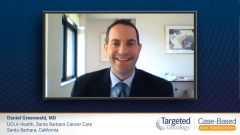
Case Impressions: A Woman With Newly Diagnosed Follicular Lymphoma
Similarities between the management of a hypothetical case of newly diagnosed follicular lymphoma compared with what is done in real-world practice.
Episodes in this series

Daniel Greenwald, MD: Hi, I’m Dr Daniel Greenwald. I’m on the clinical faculty at UCLA [The University of California, Los Angeles] oncology hematology, running the site in Santa Barbara, California. My clinical and academic focus is on lymphoma. I’ll be reviewing a hypothetical case today of the patient with frontline follicular lymphoma. We’ll be discussing some of the interesting presenting features, some of the prognostic features we address, and some of the therapies we consider in the frontline setting.
This is the case of a 45-year-old woman. She presents with a 2-month history of fatigue, abdominal pain, and enlarging lymph nodes in her right neck. She’s also noted to have a 5-pound weight loss. Her past medical history is fairly unremarkable. She’s seen on examination and noted to have cervical and axillary adenopathy measuring up to about 2 centimeters and a palpable spleen, 3 centimeters below the costal margin. Her workup starts with laboratory testing, which reveals a neutrophil count that’s low at 1500, with a total white count of 11,700 and 10,900 circulating lymphocytes. She’s anemic with a hemoglobin of 8.7 and she’s thrombocytopenic with a platelet count of 101,000. She undergoes an excisional biopsy from her cervical lymph node, and that demonstrates a population of CD20 positive, CD10 positive, CD23 negative, BCL2 [B-cell lymphoma 2] positive cells consistent with grade 2 follicular lymphoma. Bone marrow biopsy is conducted and demonstrates involvement with 43% lymphoma. Cytogenetics confirms translocation 14;18, confirming a diagnosis of follicular lymphoma. She undergoes baseline PET/CT [positron emission tomography/computed tomography] scanning, which demonstrates FDG [fluorodeoxyglucose] uptake in the known areas of lymph node involvement in the neck, axilla, mediastinum measuring up to 2 point centimeters. She’s given a provisional diagnosis of stage 3 and with confirmation bone marrow biopsy Ann Arbor stage 4. Her performance status is good with an ECOG [Eastern Cooperative Oncology Group] score of 1. The patient is treated with 6 cycles of chemotherapy, immunotherapy consisting of bendamustine [Treanda] and obinutuzumab [Gazyva] induction followed by obinutuzumab maintenance therapy. She completed 6 cycles, which were well tolerated, and she continued maintenance. However, 30 months later she complains of fever, chills and a decreased appetite. She’s noted to have a relapse.
This case is typical in some aspects, but also atypical in others. Like most forms of malignancy in adults, lymphoma and follicular lymphoma is a disease of the aging. The median age is in the early 60s and this patient is presenting at a younger age, in her 40s, so that’s somewhat unusual. She has presented with symptoms. A lot of patients present with an asymptomatic lymph node or adenopathy. They get staged and evaluated, and then they’re followed expectantly. In this case, however, she’s got several indications that would prompt initiation of therapy, and that’s something that is a little unusual in this case but warrants close attention and therapy.
Transcript edited for clarity.
Case: A 45-Year-Old Woman with Follicular Lymphoma
Initial presentation
- A 45-year-old woman presents with a 2-month history of fatigue and abdominal pain, enlarged lymph nodes in her right neck, and a 5-lb unintentional weight loss
- PMH: Unremarkable
- PE: right cervical and axillary lymph nodes palpated ~2 cm; spleen palpable 3 cm below left costal margin
Clinical workup
- Labs: ANC 1.5 x 10^9, WBC 11.7 x 10^9, lymphocytes 41%, Hb 8.7 g/dL, plt 101 x10^9, LDH 305U/L, 3.6 B2M ug/mL; HBV negative
- Excisional biopsy of cervical lymph node on IHC showed CD20+, CD10+, BCL2+, follicular lymphoma grade 2
- Bone marrow biopsy showed paratrabecular lymphoid aggregates, 43% involvement
- Cytogenetics: t(14:18) (q32;q21)
- PET/CT showed right axillary, cervical, and mediastinal lymphadenopathy (2.7 cm, 2.5 cm, and 2.6 cm respectively)
- Ann Arbor Stage IV, ECOG PS is 1
Treatment
- Patient was treated with obinutuzumab plus bendamustine chemotherapy. She completed 6 cycles and treatment was well tolerated.
- She continued on obinutuzumab maintenance.
- 30 months later, she complains of fevers, chills, and decreased appetite.








































